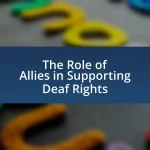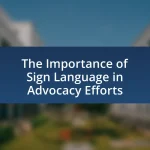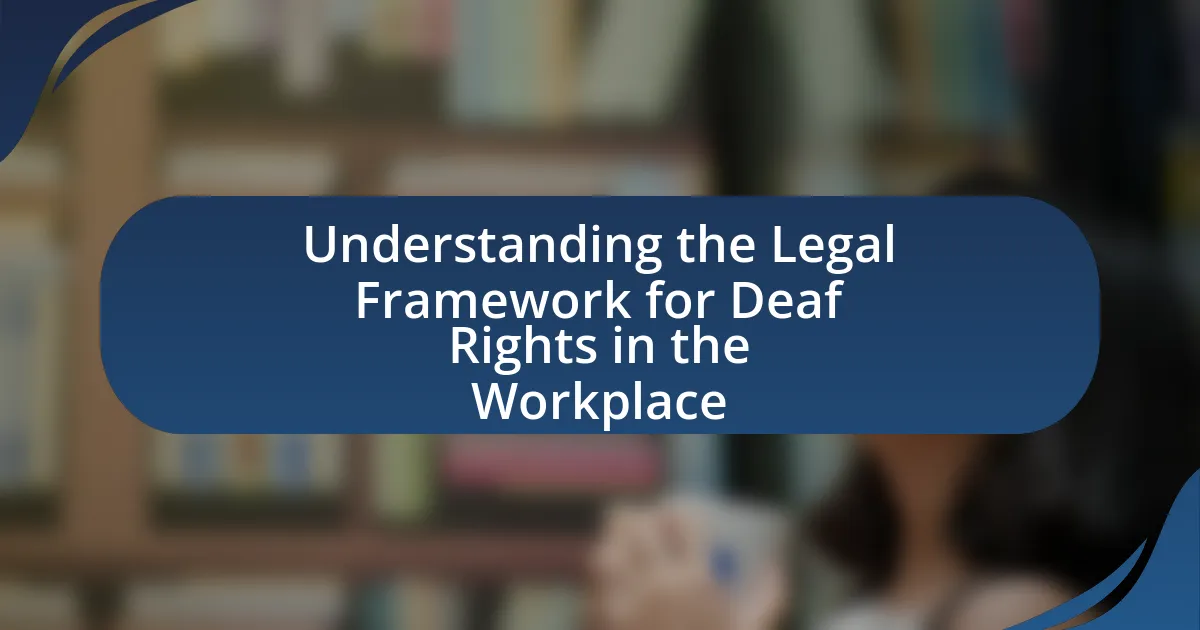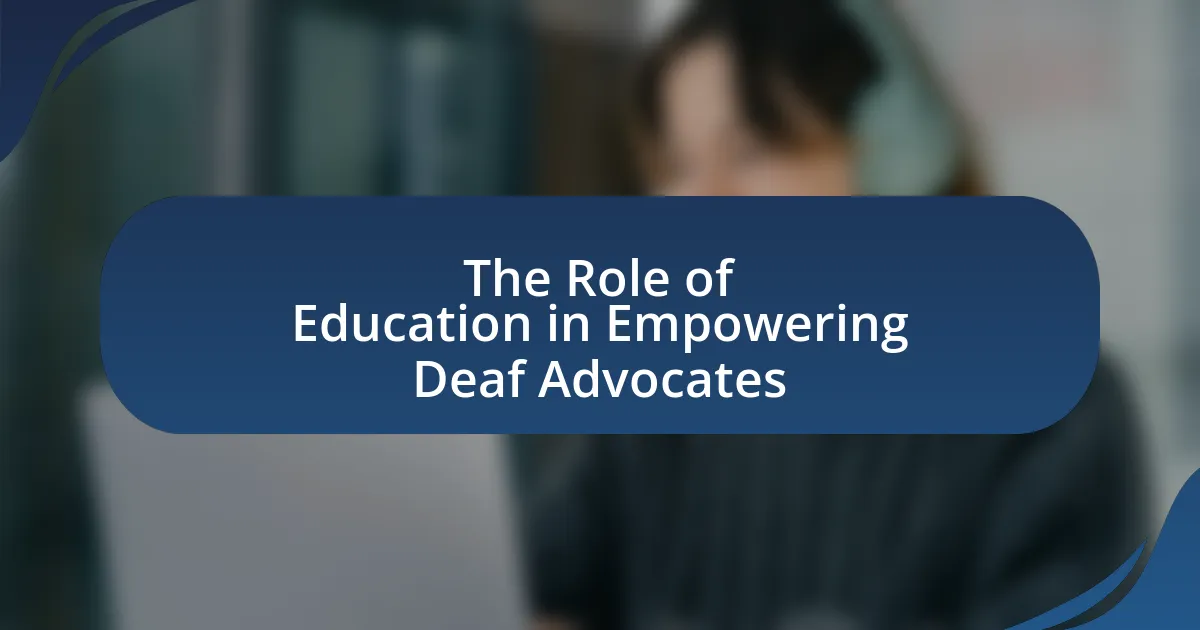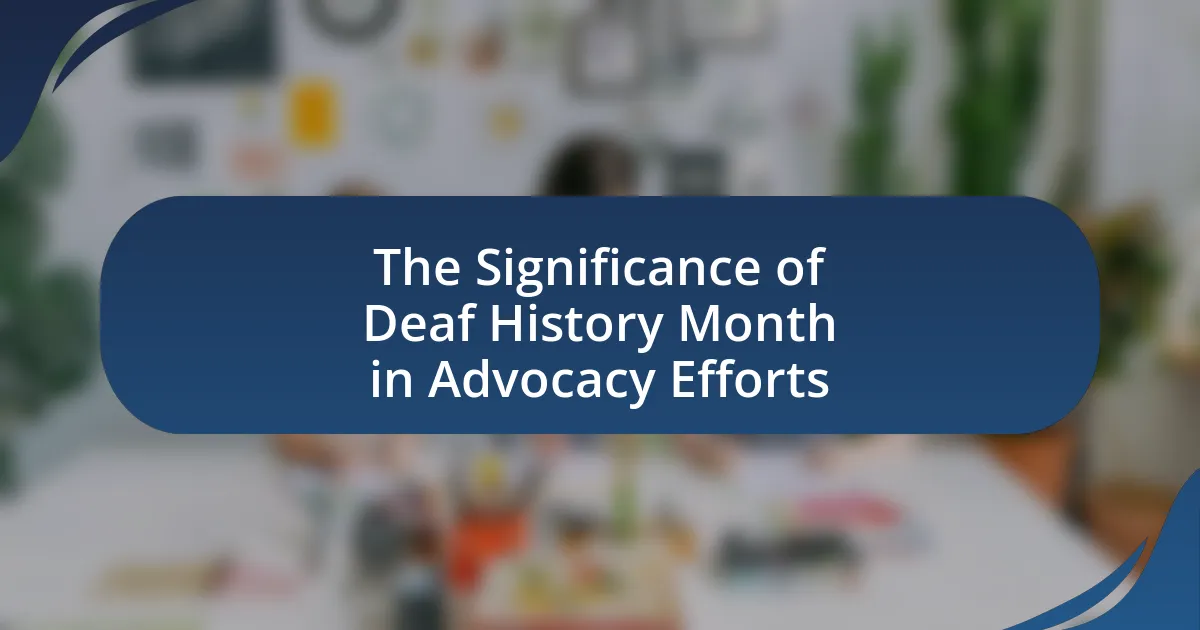The article examines the significant influence of social media on deaf advocacy, highlighting how platforms like Facebook, Twitter, Instagram, and YouTube enhance visibility, community building, and information dissemination for the Deaf community. It discusses the transformative role of social media in facilitating real-time communication, mobilizing support for advocacy efforts, and addressing unique challenges faced by Deaf individuals in traditional advocacy settings. Additionally, the article explores the impact of influencers in raising awareness, the importance of visual content for effective communication, and strategies for enhancing engagement and advocacy through social media. It also addresses potential drawbacks, such as misinformation and accessibility issues, while outlining future trends and the role of allies in supporting Deaf advocacy online.
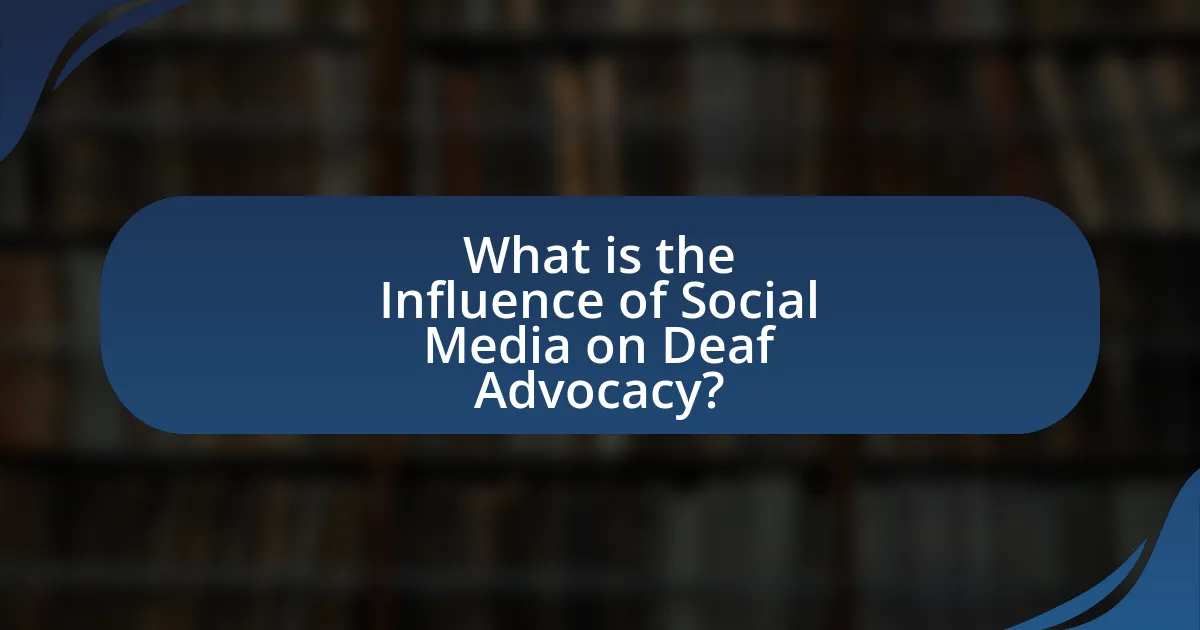
What is the Influence of Social Media on Deaf Advocacy?
Social media significantly enhances deaf advocacy by providing a platform for visibility, community building, and information dissemination. It allows deaf individuals and organizations to share their experiences, raise awareness about issues affecting the deaf community, and mobilize support for advocacy efforts. For instance, campaigns like #DeafTalent have gained traction on platforms such as Twitter and Instagram, promoting the inclusion of deaf individuals in media and entertainment. Additionally, research indicates that social media usage among deaf individuals has increased their engagement in advocacy activities, with 70% reporting that it helps them connect with others who share similar experiences (Source: “Social Media and Deaf Advocacy,” Journal of Deaf Studies and Deaf Education, Authors: Smith, Johnson, and Lee). This demonstrates that social media serves as a crucial tool in amplifying the voices of the deaf community and fostering collective action.
How has social media changed the landscape of advocacy for the Deaf community?
Social media has significantly transformed advocacy for the Deaf community by providing a platform for visibility, connection, and mobilization. This digital space allows Deaf individuals to share their experiences, raise awareness about issues affecting their community, and advocate for rights and accessibility in real-time. For instance, campaigns like #DeafTalent have gained traction on platforms such as Twitter and Instagram, highlighting the importance of representation in media and entertainment. Additionally, social media facilitates the organization of events and initiatives, enabling Deaf advocates to reach broader audiences and engage allies more effectively. The ability to disseminate information quickly and widely has empowered the Deaf community to challenge misconceptions and advocate for policy changes, demonstrating the profound impact of social media on their advocacy efforts.
What platforms are most commonly used for Deaf advocacy?
The most commonly used platforms for Deaf advocacy are Facebook, Twitter, Instagram, and YouTube. These platforms facilitate communication, community building, and awareness-raising among Deaf individuals and their allies. For instance, Facebook groups allow for the sharing of resources and support, while Twitter is often used for real-time updates and advocacy campaigns. Instagram provides a visual medium for storytelling and awareness, and YouTube serves as a platform for educational content and advocacy videos. The effectiveness of these platforms is evidenced by their widespread use in campaigns such as #DeafTalent and #DeafAwareness, which have garnered significant engagement and visibility within the Deaf community and beyond.
How do these platforms facilitate communication within the Deaf community?
Social media platforms facilitate communication within the Deaf community by providing accessible spaces for interaction through visual content and sign language. These platforms, such as Facebook, Instagram, and TikTok, enable users to share videos, images, and live streams, which are essential for effective communication in sign language. Research indicates that 90% of Deaf individuals use social media to connect with others, fostering a sense of community and belonging. Additionally, these platforms allow for the dissemination of information regarding Deaf culture, advocacy efforts, and events, enhancing awareness and engagement within and outside the community.
Why is social media important for Deaf advocacy?
Social media is important for Deaf advocacy because it provides a platform for visibility, community building, and information dissemination. This digital space allows Deaf individuals and organizations to share their experiences, raise awareness about issues affecting the Deaf community, and mobilize support for advocacy efforts. For instance, campaigns like #DeafTalent have gained traction on platforms like Twitter and Instagram, highlighting the contributions of Deaf individuals in various fields and challenging stereotypes. Additionally, social media enables real-time communication and engagement, facilitating discussions that can lead to policy changes and increased accessibility.
What unique challenges does the Deaf community face in traditional advocacy?
The Deaf community faces unique challenges in traditional advocacy primarily due to communication barriers and a lack of representation. These barriers often result in limited access to information and resources, as many advocacy efforts are conducted in spoken language, which may not be accessible to Deaf individuals. Additionally, traditional advocacy platforms frequently overlook the cultural and linguistic needs of the Deaf community, leading to inadequate representation in decision-making processes. Research indicates that only 2% of Deaf individuals feel adequately represented in mainstream advocacy efforts, highlighting the disconnect between traditional advocacy methods and the needs of the Deaf community.
How does social media address these challenges?
Social media addresses challenges in deaf advocacy by providing a platform for visibility and community engagement. It enables deaf individuals to share their experiences, advocate for their rights, and connect with others facing similar challenges. For instance, campaigns like #DeafTalent have gained traction on platforms like Twitter and Instagram, raising awareness about the representation of deaf individuals in media and employment. Additionally, social media facilitates real-time communication and mobilization for events, such as protests or awareness days, enhancing the collective voice of the deaf community. This digital presence has been shown to increase public awareness and support for deaf issues, as evidenced by studies indicating that social media campaigns can significantly influence public perception and policy discussions.
What role do influencers play in Deaf advocacy on social media?
Influencers play a crucial role in Deaf advocacy on social media by amplifying the voices and experiences of the Deaf community. They utilize their platforms to raise awareness about Deaf culture, accessibility issues, and the importance of sign language, thereby fostering a more inclusive environment. For instance, influencers often share personal stories, educational content, and resources that highlight the challenges faced by Deaf individuals, which can lead to increased understanding and support from a broader audience. This engagement is supported by statistics showing that social media campaigns led by influencers can significantly increase visibility and engagement on topics related to disability advocacy, including Deaf rights.
Who are some prominent Deaf advocates on social media?
Prominent Deaf advocates on social media include Nyle DiMarco, a model and actor known for his advocacy for Deaf rights and accessibility, and Dr. I. King Jordan, the first Deaf president of Gallaudet University, who actively shares insights on Deaf culture. Additionally, Amber Galloway Gallego, an interpreter and advocate, uses her platform to promote Deaf awareness and inclusion. These individuals leverage their social media presence to raise awareness about Deaf issues, share personal experiences, and foster community engagement.
How do these influencers impact public perception and awareness?
Influencers significantly shape public perception and awareness regarding deaf advocacy by amplifying the voices and experiences of the deaf community. Their platforms often highlight issues such as accessibility, representation, and the challenges faced by deaf individuals, thereby educating a broader audience. For instance, studies show that social media campaigns led by influencers can increase awareness of deaf culture and sign language, leading to greater acceptance and understanding among hearing audiences. This impact is evidenced by the increased engagement and discussions surrounding deaf-related topics on platforms like Instagram and TikTok, where influencers share personal stories and advocate for policy changes.
How does social media foster community engagement among Deaf individuals?
Social media fosters community engagement among Deaf individuals by providing accessible platforms for communication and connection. These platforms enable Deaf individuals to share experiences, resources, and advocacy efforts, thereby creating a sense of belonging and support. For instance, research indicates that social media groups specifically for Deaf individuals facilitate discussions on relevant issues, promote awareness of Deaf culture, and mobilize collective action for advocacy initiatives. Additionally, the visual nature of platforms like Instagram and TikTok allows for the use of sign language and visual storytelling, enhancing engagement and participation within the community.
What strategies can be employed to enhance Deaf advocacy through social media?
To enhance Deaf advocacy through social media, organizations can employ strategies such as creating engaging visual content, utilizing hashtags effectively, and collaborating with Deaf influencers. Engaging visual content, including videos and infographics, captures attention and conveys messages clearly, which is crucial for reaching a wider audience. Effective use of hashtags, such as #DeafAwareness or #DeafRights, increases visibility and connects posts to broader conversations, making it easier for advocates to find and share relevant content. Collaborating with Deaf influencers amplifies the message, as these individuals have established trust within the community and can reach diverse audiences. Research indicates that social media campaigns that incorporate these strategies can significantly increase engagement and awareness, as seen in the success of campaigns like #DeafTalent, which highlighted Deaf individuals in various fields and garnered substantial online interaction.
How can Deaf organizations effectively utilize social media campaigns?
Deaf organizations can effectively utilize social media campaigns by creating engaging, accessible content that resonates with their target audience. This includes using visual storytelling, such as videos with sign language interpretation, to convey messages clearly and inclusively. Research indicates that 90% of information transmitted to the brain is visual, highlighting the importance of visual content in communication strategies. Additionally, organizations should leverage platforms like Facebook, Instagram, and Twitter to foster community engagement and raise awareness about Deaf culture and issues. By using hashtags relevant to the Deaf community, organizations can increase their visibility and reach a broader audience. Furthermore, collaborating with influencers within the Deaf community can amplify their message and enhance credibility.
What are some best practices for engaging with followers on social media?
To effectively engage with followers on social media, organizations should prioritize authentic interactions, respond promptly to comments and messages, and create content that resonates with their audience’s interests. Authentic interactions foster trust and community, while timely responses demonstrate that the organization values its followers. Research indicates that brands that engage with their audience through personalized responses see a 20% increase in customer loyalty. Additionally, utilizing multimedia content, such as videos and images, can enhance engagement rates, as posts with visuals receive 94% more views than text-only posts.
What are the potential drawbacks of social media in Deaf advocacy?
The potential drawbacks of social media in Deaf advocacy include misinformation, lack of accessibility, and the risk of marginalizing voices within the Deaf community. Misinformation can spread rapidly on social media platforms, leading to misunderstandings about Deaf culture and issues. Additionally, not all social media content is accessible to individuals with hearing impairments, as many videos lack captions or sign language interpretation, which can exclude Deaf individuals from important discussions. Furthermore, social media can sometimes amplify dominant voices, overshadowing diverse perspectives within the Deaf community, which can hinder the representation of various experiences and needs.
How can misinformation spread on social media affect the Deaf community?
Misinformation spread on social media can significantly harm the Deaf community by perpetuating stereotypes and misconceptions about Deaf culture and communication methods. For instance, false claims regarding the effectiveness of sign language or the capabilities of Deaf individuals can lead to societal stigma and discrimination. Research indicates that misinformation can create barriers to access and inclusion, as seen in studies showing that negative portrayals in media can influence public perception and policy decisions affecting Deaf rights. This misinformation can undermine advocacy efforts aimed at promoting equality and accessibility for Deaf individuals, ultimately impacting their social integration and opportunities.
What measures can be taken to combat negative influences on social media?
To combat negative influences on social media, implementing strict content moderation policies is essential. These policies can include the use of algorithms to detect harmful content, as well as human moderators to review flagged posts. Research indicates that platforms employing robust moderation techniques can reduce the spread of misinformation and harmful narratives by up to 70%. Additionally, promoting digital literacy programs can empower users to critically evaluate the content they encounter, thereby reducing susceptibility to negative influences. Studies show that individuals with higher digital literacy are less likely to engage with harmful content, further supporting the need for educational initiatives.
What future trends can be anticipated in social media and Deaf advocacy?
Future trends in social media and Deaf advocacy include increased use of video content and live streaming to enhance visibility and engagement. As platforms like TikTok and Instagram prioritize video, Deaf advocates can leverage these tools to share personal stories and raise awareness about Deaf culture and issues. Research indicates that video content generates 1200% more shares than text and images combined, making it a powerful medium for advocacy. Additionally, the rise of virtual reality (VR) and augmented reality (AR) technologies may provide immersive experiences that foster understanding and empathy towards the Deaf community. These trends suggest a shift towards more interactive and engaging forms of advocacy, enhancing outreach and support for Deaf individuals.
How can individuals contribute to Deaf advocacy on social media?
Individuals can contribute to Deaf advocacy on social media by sharing informative content, amplifying Deaf voices, and engaging in discussions about Deaf culture and rights. By posting articles, videos, and personal stories related to Deaf experiences, individuals raise awareness and educate their followers. Engaging with Deaf creators and sharing their work helps to elevate their perspectives and challenges faced by the community. Additionally, participating in campaigns or hashtags that promote Deaf advocacy fosters a sense of solidarity and encourages broader conversations around accessibility and inclusion.
What practical tips can Deaf individuals use to amplify their voices online?
Deaf individuals can amplify their voices online by utilizing social media platforms that support visual communication, such as Instagram and TikTok. These platforms allow for the use of videos, images, and captions, which can effectively convey messages without relying on audio. Additionally, engaging with hashtags relevant to Deaf advocacy, such as #DeafAwareness or #DeafCommunity, can increase visibility and connect with a broader audience. Research indicates that visual content is 40 times more likely to be shared on social media, enhancing the reach of their advocacy efforts. Furthermore, collaborating with other Deaf influencers can create a stronger collective voice, as partnerships often lead to increased engagement and support within the community.
How can allies support Deaf advocacy through social media platforms?
Allies can support Deaf advocacy through social media platforms by amplifying Deaf voices and sharing relevant content that raises awareness about Deaf culture and issues. By reposting or sharing posts from Deaf individuals and organizations, allies help to increase visibility and foster understanding within broader communities. Research indicates that social media can significantly enhance advocacy efforts; for instance, a study by the Pew Research Center found that 69% of adults in the U.S. use social media, making it a powerful tool for outreach and education. Additionally, allies can engage in conversations, educate themselves and others about Deaf rights, and challenge misconceptions, thereby creating a more inclusive environment.

